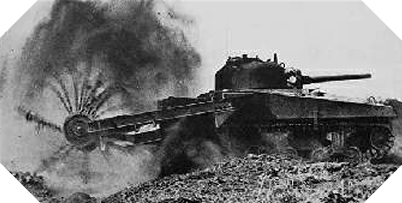Crab tank
History, technical sheet and photo

Crab tank history
To support the infantry through the minefields on the operational grounds in Europe and the Pacific, the Allied military engineers decided to add to some of their tanks a new system devised by the military engineer Percy Hobart.
Thus, the « Crab » version of the Sherman tank (which is presented here) is born. It is a model of de-mining tank equipped with flails: two metal arms located at the front of the tank and connected by a cylinder. Around this cylinder, long chains are hung and touch the ground.
In contact with an anti-personal mine or anti-tank mine, the chains trigger the device: the explosion destroys no element of the tank that can continue its progression inside the minefield.
The Crab tank is one of the « funnies« , a nickname given by the British and American military to the engines invented by the British General Percy Hobart and intended to best support the land forces during the landing of Normandy.
Sherman Crab tank specification
Creator: Britain
Users: Britain, United-States, Canada
Denomination: Sherman Crab
Length: 6,06 m
Width: 2,62 m
Height: 2,74 m
Weight: 31,600 kg
Maximum speed: 40 km/h
Operational range: 160 km
Main armament: one 75 mm gun
Secondary armament: one Browning 7.62 mm machine gun for the co-pilot and one Browning 7.62 mm machine gun in the barrel axis from the turret
Engine: 5 6-cylinder petrol engines Multibank Chrysler A57, 425 hp, 2,850 rpm
Crew: 5 (commander, gunner, loader/radio operator, driver, co-driver/hull gunner)
Chassis armor: 50 mm (front), 38 mm (rear), 38 mm (flancs)
Turret armor: 75 mm (front), 50 mm (rear), 50 mm (flancs)
![]() Back to the Battle of Normandy tanks
Back to the Battle of Normandy tanks
